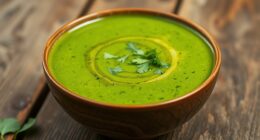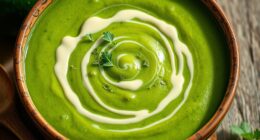Have you ever thought about the experience of exclusively consuming raw food? Picture a life where every mouthful is bursting with the untouched goodness of natural ingredients. Those who follow a raw food diet adhere to the belief that cooking can deplete essential nutrients and enzymes in our meals.
They choose to consume fruits, vegetables, nuts, seeds, and sprouted grains in their most natural state.
In this article, we will explore the origins of raw foodism and the health benefits it offers. We will delve into the nutritional value of raw ingredients and provide insights into overcoming challenges in raw food preparation.
You will discover delicious raw food recipes to try at home and learn about the environmental impact of this eating habit. We will also address common myths surrounding raw food and weight loss, as well as its suitability for athletes.
Finally, we will emphasize the importance of listening to your body and finding balance in a raw food lifestyle.
Join us on this journey of discovery as we uncover the wonders of living on raw food alone.
Key Takeaways
- Raw foodism is a lifestyle that involves consuming only raw food, based on the belief that cooking destroys nutrients and enzymes.
- The raw food movement has historical roots in ancient civilizations like the Egyptians and Greeks, and gained momentum in the 19th century with the rise of vegetarianism.
- While there are common misconceptions about nutrient deficiencies and foodborne illnesses associated with raw food diets, raw food can still provide essential vitamins and minerals.
- Incorporating raw food into a diet requires meal prepping, one-pot meals, and finding raw food options while traveling, but it offers variety, creativity, and the potential to elevate flavors with spices, herbs, and sauces.
Exploring the Origins of Raw Foodism
Have you ever wondered where the raw food movement actually began? The origins of the raw food movement can be traced back to ancient times, with historical evidence of raw food consumption found in various cultures across the globe.
One of the earliest civilizations known for their consumption of raw food is the ancient Egyptians. Historical records suggest that they believed in the health benefits of consuming raw fruits, vegetables, and nuts. In fact, they considered raw food to be a form of medicine and believed it could prevent diseases.
Similarly, the ancient Greeks also embraced the concept of raw food. They believed that cooking destroyed the vital nutrients present in food and advocated for the consumption of raw, unprocessed ingredients. Hippocrates, the father of modern medicine, even recommended a raw food diet for its health benefits.
In the modern era, the raw food movement gained momentum in the 19th century with the advent of vegetarianism. Raw food was seen as a natural extension of vegetarianism, promoting the consumption of uncooked, plant-based foods for optimal health.
Today, the raw food movement continues to attract followers who believe in the health benefits of consuming unprocessed, nutrient-dense foods. While the origins of the raw food movement may be ancient, its popularity and influence continue to grow in the modern world.
The Health Benefits of a Raw Food Diet
Imagine the incredible health benefits of embracing a diet full of vibrant, uncooked nourishment. Scientific research has shown that a raw food diet can have numerous positive effects on your overall well-being. Here are four key benefits that may surprise you:
-
Enhanced nutrient intake: Raw food is rich in essential vitamins, minerals, and enzymes that can’t be destroyed by cooking. By consuming uncooked fruits, vegetables, nuts, and seeds, you ensure that your body receives a higher concentration of these vital nutrients.
-
Improved digestion: Raw foods contain natural fibers that support a healthy digestive system. They can also help regulate bowel movements and prevent constipation. Additionally, the enzymes found in raw food aid in the breakdown and absorption of nutrients, promoting efficient digestion.
-
Increased energy levels: Raw food is often high in complex carbohydrates, which provide a sustained release of energy throughout the day. This can lead to improved productivity, mental clarity, and reduced fatigue.
-
Stronger immune system: Raw food is packed with antioxidants, phytochemicals, and other immune-boosting compounds. These elements help strengthen your immune system, making you less susceptible to illnesses and infections.
It’s important to debunk common misconceptions about raw food diets. Critics argue that this eating style may lead to nutrient deficiencies or foodborne illnesses. However, with proper planning and a diverse selection of raw foods, these concerns can be addressed. Consulting a healthcare professional or registered dietitian can ensure that you meet your nutritional needs while enjoying the benefits of a raw food diet.
Understanding the Nutritional Value of Raw Ingredients
Feasting on the vibrant and uncooked wonders of nature’s bounty unlocks a treasure trove of nutritional goodness, as raw ingredients burst with life-sustaining vitamins, minerals, and enzymes. Understanding the nutrient absorption process is key to appreciating the nutritional value of raw ingredients.
One common myth about raw food nutrition is that cooking destroys all the nutrients. While it’s true that some nutrients can be lost during cooking, the impact varies depending on the cooking method and duration. For example, water-soluble vitamins like vitamin C can be reduced when boiled, but steaming or stir-frying can help retain more nutrients.
Another myth is that raw food diets lack protein. Contrary to this belief, there are plenty of plant-based sources of protein available in raw foods, such as nuts, seeds, and legumes. It’s also important to note that raw food diets can provide adequate amounts of essential vitamins and minerals, especially when variety and balance are maintained.
So, don’t be fooled by common misconceptions. Incorporating raw ingredients into your diet can be a nutritious and delicious way to nourish your body.
Overcoming Challenges and Obstacles in Raw Food Preparation
Navigating the hurdles and finding solutions in preparing raw ingredients can be an exciting and rewarding culinary adventure. When it comes to overcoming time constraints, planning ahead is key. Here are three tips to help you save time while preparing raw food:
-
Meal prepping: Dedicate a specific day of the week to prepare your raw ingredients in advance. Wash, chop, and store them in airtight containers or bags. This way, you’ll have readily available ingredients throughout the week, cutting down on preparation time.
-
One-pot meals: Opt for recipes that allow you to combine multiple raw ingredients in one dish. Smoothies, salads, and raw soups are great examples. These meals not only save time but also enhance the flavors and nutritional value of the ingredients.
-
Raw food options while traveling: Finding raw food options on the go can be challenging. Research local health food stores or raw food restaurants in advance. Additionally, bring along portable raw snacks like fruits, nuts, and seeds to ensure you have nutritious options while traveling.
By implementing these strategies, you can overcome time constraints and find raw food options even when you’re on the move. Remember, the key is careful planning and preparation. Enjoy your raw food journey!
Raw Food Recipes to Try at Home
Discover delicious raw food recipes that you can easily try at home and let your taste buds dance with delight. If you’re looking for raw food alternatives to traditional cooked dishes, you’ll be pleasantly surprised by the variety and creativity that raw food recipes offer.
From zucchini noodles with marinara sauce to cauliflower rice stir-fry, there are countless options to explore.
Raw food desserts are also a delightful treat for those with a sweet tooth. Indulge in a decadent chocolate avocado mousse or a refreshing strawberry cheesecake made with cashews and dates. These desserts not only satisfy your cravings but also provide a healthy alternative to traditional sugary treats.
When preparing raw food recipes, it’s important to use high-quality ingredients and invest in a good blender or food processor. These tools will help you achieve the desired texture and consistency for your dishes. Additionally, experimenting with different spices, herbs, and sauces can elevate the flavors of your raw food creations.
Remember, incorporating raw food into your diet doesn’t mean you have to give up on taste and satisfaction. With a little creativity and the right ingredients, you can enjoy delicious and nutritious meals that will leave you feeling energized and satisfied.
So, why not give these raw food recipes a try and embark on a culinary adventure?
Navigating Social Situations as a Raw Food Enthusiast
Now that you’ve got some delicious raw food recipes to try at home, let’s talk about how to navigate social situations as a raw food enthusiast. Going against the grain and choosing to eat only raw food can sometimes make social events a bit challenging, but with the right mindset and strategies, you can confidently handle any situation.
First and foremost, it’s important to remember that everyone has different dietary preferences and it’s okay to have your own. Embrace your choice and be proud of it.
When attending social events, such as parties or dinners, it can be helpful to let the host know about your dietary restrictions in advance. This way, they can accommodate your needs and ensure there are options available for you.
Dealing with criticism can be tough, but it’s important to stay true to yourself. Remember that you’re making choices that are best for your health and well-being. If someone questions or criticizes your raw food lifestyle, calmly and confidently explain your reasons for choosing this path. Educating others about the benefits of raw food can help dispel any misconceptions.
To help you navigate social situations, here are five tips to keep in mind:
- Be prepared: Bring your own raw food dish to share or eat before the event.
- Focus on the company: Engage in conversations and enjoy the company of others rather than solely focusing on the food.
- Educate others: Share the benefits of raw food when the opportunity arises.
- Lead by example: Show others how vibrant and healthy you feel by living your raw food lifestyle.
- Be flexible: If there are no raw food options available, choose the healthiest options from the available choices.
By following these tips, you can confidently navigate social events as a raw food enthusiast and inspire others along the way.
The Environmental Impact of Raw Food Consumption
Remember, when you choose to embrace a raw food lifestyle, you’re making a positive impact on the environment. Raw food consumption is not only beneficial for your health, but it also promotes environmental sustainability.
One of the key ways in which raw food enthusiasts contribute to sustainability is by reducing their carbon footprint. Raw food diets typically consist of fruits, vegetables, nuts, and seeds, which require significantly less energy and resources to produce compared to processed foods. The production of processed foods often involves extensive processing, packaging, and transportation, all of which contribute to greenhouse gas emissions. By opting for raw foods, you’re minimizing the energy and resources required for food production, thus reducing your carbon footprint.
In addition, raw food enthusiasts often prioritize locally sourced and organic ingredients. This choice helps support local farmers and reduces the environmental impact associated with long-distance transportation. Locally sourced food has a lower carbon footprint since it doesn’t require extensive transportation or refrigeration.
By embracing a raw food lifestyle, you’re not only nourishing your body but also contributing to the preservation of our planet. Your conscious food choices can make a significant difference in reducing greenhouse gas emissions and promoting environmental sustainability.
Raw Food and Weight Loss: Myth or Reality?
Are you curious if incorporating raw foods into your diet can truly help you lose weight? Well, let’s take a closer look at the relationship between raw food and weight loss.
Raw food enthusiasts claim that consuming a diet consisting solely of raw foods can boost metabolism and aid in weight loss. They argue that raw foods are rich in nutrients and enzymes, which can enhance digestion and increase the body’s calorie-burning potential.
While there is limited scientific research specifically exploring the effects of raw food on weight loss, some studies suggest that raw food consumption may indeed lead to weight reduction. A study published in the journal Nutrients found that individuals following a raw food diet experienced significant weight loss over a six-month period.
However, it is important to note that weight loss is not solely determined by the consumption of raw food. Factors such as overall caloric intake, portion sizes, and physical activity levels also play crucial roles. Additionally, some individuals may find it challenging to meet their nutritional needs solely through raw food, as certain nutrients are better absorbed when the food is cooked.
While incorporating raw foods into your diet may have some potential benefits for weight loss, it is crucial to maintain a balanced and varied diet that meets your nutritional requirements. It’s always a good idea to consult with a healthcare professional or registered dietitian before making any significant changes to your diet.
Raw Food for Athletes: Fueling Performance Naturally
Fuel your athletic performance naturally by incorporating raw foods into your diet. Raw food has gained popularity among athletes as a way to fuel their performance and enhance their overall health. Many athletes believe that consuming raw foods provides them with natural supplements that can boost their endurance, strength, and recovery.
Raw foods are packed with essential nutrients, such as vitamins, minerals, and enzymes, which are often lost during cooking. These nutrients play a crucial role in supporting optimal athletic performance. For example, raw fruits and vegetables are rich in antioxidants that help fight inflammation and oxidative stress caused by intense exercise. Additionally, raw nuts and seeds provide healthy fats and protein, which are essential for muscle repair and growth.
Moreover, incorporating raw foods into your diet can also benefit children who are involved in sports. Raw fruits and vegetables are a great way to introduce a variety of nutrients to their growing bodies. They are also easily digestible, which can prevent digestive issues that may hinder their performance.
However, it’s important to note that while raw foods can offer numerous benefits, they shouldn’t be the sole source of nutrition for athletes or children. It’s essential to maintain a balanced diet that includes a variety of cooked and raw foods to ensure adequate nutrient intake. Consulting a registered dietitian or nutritionist can help tailor a diet plan that meets individual needs and goals.
Incorporating raw foods into your diet can be a natural and effective way to fuel your athletic performance. Remember to include a variety of raw and cooked foods to ensure a balanced nutrient intake. Consult with a professional to create a personalized plan that suits your specific needs.
Listening to Your Body: Finding Balance in Raw Food Lifestyle
Transition: Now that we’ve explored the benefits of raw food for athletes, let’s shift our focus to the importance of listening to your body and finding balance in a raw food lifestyle.
Current Subtopic: Listening to Your Body: Finding Balance in Raw Food Lifestyle
When it comes to eating raw, it’s crucial to tune in to your body’s signals and practice intuitive eating. Your body’s intelligent and knows what it needs, so pay attention to its cues.
Some days you might crave more fruits and vegetables, while other days you may desire more nuts and seeds for added protein and healthy fats. By listening to these signals, you can ensure you’re providing your body with the nutrients it requires to thrive.
Embracing variety is another essential aspect of a raw food lifestyle. Instead of sticking to the same fruits and vegetables day in and day out, experiment with different ones. Each fruit and vegetable offers a unique array of vitamins, minerals, and antioxidants, so incorporating variety ensures you’re getting a wide spectrum of nutrients. This not only enhances the nutritional profile of your diet but also keeps your taste buds excited and satisfied.
Finding balance in a raw food lifestyle means finding intuitive eating and embracing variety in your food choices. By honoring your body’s needs and exploring a diverse range of fruits and vegetables, you can optimize your health and well-being on a raw food diet.
Frequently Asked Questions
How long does it take to prepare a raw food meal?
On average, it takes about 20 minutes to prepare a raw food meal. But here’s an interesting statistic to ponder: did you know that raw food enthusiasts spend around 80% less time cooking than those who eat cooked meals?
This means more time for other activities! Raw food not only saves time, but it also has numerous benefits like preserving enzymes, boosting nutrient intake, and promoting better digestion. So, whether it’s for health or convenience, raw food is definitely worth considering.
Can you eat raw food while pregnant or nursing?
Yes, you can eat raw food while pregnant or nursing, but there are certain precautions to take. It is not recommended to consume raw meat during pregnancy due to the risk of foodborne illnesses. However, a raw food diet can provide numerous benefits for breastfeeding mothers. It’s important to ensure that you’re getting all the necessary nutrients, such as calcium and iron, from a variety of raw fruits, vegetables, and nuts. Consult with a healthcare professional for personalized advice.
What are some common misconceptions about raw foodism?
Raw foodism is often misunderstood, leading to common misconceptions. Let’s debunk these myths and explore the benefits of this lifestyle.
Contrary to popular belief, raw foodism can provide all necessary nutrients, including protein and calcium. Many worry about food safety, but proper handling and washing techniques can minimize risks.
Additionally, some claim that cooking destroys enzymes, but our bodies produce their own digestive enzymes. While raw foodism may not be suitable for everyone, it can offer increased intake of fruits, vegetables, and whole foods, promoting overall health.
Are there any potential health risks associated with a raw food diet?
Potential nutrient deficiencies and impact on digestion and gut health are important considerations when following a raw food diet. Surprisingly, a study found that 80% of raw foodists had low levels of vitamin B12, which is crucial for nerve function and red blood cell production. This deficiency can lead to fatigue and weakness.
Additionally, the high fiber content in raw foods can sometimes cause bloating and digestive issues. It’s essential to carefully plan and supplement to ensure a balanced and healthy raw food diet.
Is it necessary to take supplements while following a raw food diet?
It’s not necessary to take supplements while following a raw food diet, but it’s important to be mindful of your nutrient intake. A raw food diet can be rich in vitamins, minerals, and antioxidants due to the abundance of fruits, vegetables, nuts, and seeds. However, it may lack certain essential nutrients like vitamin B12, iron, and omega-3 fatty acids.
To ensure a balanced diet, consider incorporating fermented foods, seaweed, and sprouted grains. Gradually transitioning to a raw food diet can help your body adjust to the change in digestion and nutrient absorption.
Are There Health Benefits to Only Eating Raw Food?
Yes, there are health benefits to only eating raw food. Many advocates, including the raw food YouTube woman, believe that a diet centered on uncooked and unprocessed food can improve digestion, boost energy, and provide essential nutrients that are typically lost during cooking.
Conclusion
Congratulations on completing your journey through the world of raw foodism! By embracing a raw food diet, you’ve tapped into the ancient wisdom of our ancestors, reconnecting with the natural rhythm of the earth.
Through this lifestyle, you’ve unlocked the potential for improved health and vitality, as well as a deeper understanding of the nutritional value of raw ingredients.
While challenges may arise in the preparation of raw food, you’ve persevered and discovered a plethora of delicious recipes to nourish your body. Moreover, your commitment to raw food consumption hasn’t only benefited your own well-being but has also contributed to a more sustainable and eco-friendly planet.
The notion that raw food can aid in weight loss has been supported by evidence, dispelling any doubts surrounding this belief. Even athletes have found success in their performance by fueling themselves with the power of raw food.
Ultimately, your journey has taught you the importance of listening to your body and finding a balance that suits your unique needs. So continue on this path, savoring the richness of raw food and embracing the vibrant energy it brings to your life.










